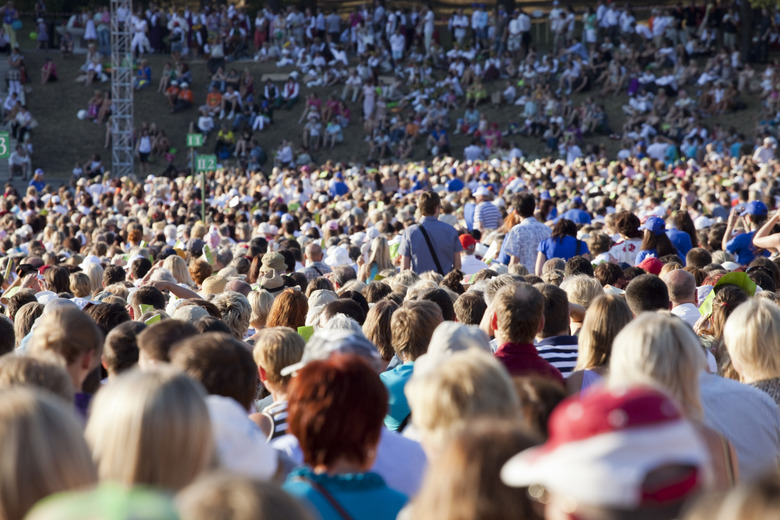How To Estimate Crowd Density
Knowing the size of a crowd is useful to show how many people turned out to support, or protest, an event. Journalists use their own estimates of crowd density to check facts reported by proponents of a cause because its quite common for numbers to be padded. If you want to find credible numbers for how many people attended an event, use those from a disinterested third party, or better yet, do your own estimate. Just keep in mind that crowd size is never evenly distributed or static. To compensate for this, a method that assigns values for high density and low density areas results in a more accurate number. Also, using a photo taken when the crowd is at peak number captures the most people.
Step 1
Determine the square footage of the area in question. Do this by obtaining it from the owner of the facility or using measuring tools in geospatial software, such as ArcMap or Google Earth, to calculate square footage from a recent satellite photo.
Step 2
Acquire a high-resolution satellite photo taken at the time the crowd was at its peak number. Mark out a grid on the photo so each box is in proportion to 10 square feet at the event. You can do this with software or using a ruler and marker.
Step 3
Assign a density value to each box. Low density boxes with one person's head receive a density number of 10, medium density boxes with two or three heads receive the number 4.5, and high density boxes with four or more heads receive a density of 2.5. For very large photos, you can estimate number of heads per box instead of counting, but counting gives more precise numbers.
Step 4
Add up the number of boxes for each density value. Sum the total square feet for each density value. For example, you have ten total boxes with four boxes at a 10 density value, three boxes at 4.5 density value, and three boxes at 2.5 density value. The total square footage for low density boxes is 4 boxes multiplied by 10 square feet for a total of 40 square feet. Medium density boxes occupy 30 square feet, as do high density boxes.
Step 5
Find the estimated number of people for each density value by dividing the total square footage for a density value by the density value itself. Continuing our example, low density boxes have 40 total square feet, divided by a density value of 10, which equals four people. Medium density boxes have a total of 30 square feet, divided by a density value of 4.5, equals seven people, and the high density boxes have a total of 12 people.
Step 6
Add the total number of people for each density to get the total crowd size of 23 people.
Things Needed
- Geospatial software
- Areal photo of subject area without crowd
- Areal photo of crowd
- Ruler
- Marker
- Calculator, optional
Cite This Article
MLA
Williams, Diana K.. "How To Estimate Crowd Density" sciencing.com, https://www.sciencing.com/estimate-crowd-density-7824574/. 24 April 2017.
APA
Williams, Diana K.. (2017, April 24). How To Estimate Crowd Density. sciencing.com. Retrieved from https://www.sciencing.com/estimate-crowd-density-7824574/
Chicago
Williams, Diana K.. How To Estimate Crowd Density last modified March 24, 2022. https://www.sciencing.com/estimate-crowd-density-7824574/
